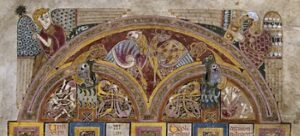The Book of Kells: Image and Text / The Canon Tables
- Elaine Harrington
- May 31, 2017
Student Exhibition, MA in Medieval History
The Canon Tables
In the fourth century, Eusebius of Caesarea (263-339) created a series of ten canon tables to demonstrate the harmony of the Gospel accounts by cross-referencing corresponding sections within the Gospels. Eusebius elaborated on a method used in the third century by Ammonius of Alexandria, which took Matthew’s Gospel as the key reference point and compared passages from other Gospels to those in Matthew’s account. The Eusebian canon tables show which sections of the Gospels are common to all four accounts, which stories feature only in three or two Gospels and which are distinctive to each Gospel narrative. The canon tables can be found in Insular Gospel books including the Book of Kells, where they precede the text of the Gospels.

In the Book of Kells, the canon tables are placed within elaborate architectural structures, with columns supporting an arch. They span eight folios and are followed by two folios of canons set in a grid format. The four Evangelist symbols depicted within the arches are used to embellish the tables but also act as a visual aid by signifying the Gospels that are being compared. As readers looked across the page, they could discern, for example, which section number in Matthew’s Gospel corresponds to which section number in the Gospels of Mark, Luke or John.

For the tables to be used, the corresponding sections have to be signified throughout the Gospel text which is not the case in the Book of Kells, confirming that the manuscript was intended for ceremonial display, rather than for everyday liturgical use. However, the very presence of canon tables in the Gospel manuscript such as the Book of Kells expresses the harmony between the Evangelists and their writings. By comparing the similarities between the distinctive Gospels, the tables reiterate the notion of a single divinely inspired narrative of the four texts. Jennifer O’Reilly argued that the canon tables demonstrate how the four Gospels revealed individual and complementary facets of the same truth in four different ways. The tables provide the reader with a visualisation of textual similarities found in the Gospels and combined with the images of intertwining symbols depicted in the arches, they emphasise the harmony of the accounts.
Kate O’Brien
Further reading
Friend, A. M., ‘The Canon Tables of the Book of Kells’, in W. R. Koehler, ed., Medieval Studies in Memory of Arthur Kingsley Porter, 2 vols (Cambridge, MA: Harvard University Press, 1939), vol. 2, pp. 611-641.
Mullins, Elizabeth, ‘The Insular Reception of the Eusebian Canon Tables‘ (PhD thesis, University College Cork, 2001).
Mullins, Elizabeth, ‘The Canon Tables in Boulogne, Bibliotheque Municipale, MS 10’, in Diarmuid Scully and Elizabeth Mullins, ed., Listen O Isles, Unto Me: Studies in Medieval Word and Image in Honour of Jennifer O’Reilly (Cork: Cork University Press, 2011), pp. 302-312.
Netzer, Nancy, ‘The Origin of the Beast Canon Tables Reconsidered’, in Felicity O’Mahony, ed., The Book of Kells: Proceedings of a Conference at Trinity College Dublin, 6-9 September 1992 (Aldershot: Scolar Press, 1994), pp. 183-195.
O’Loughlin, Thomas, ‘Harmonizing the Truth: Eusebius and the Problem of the Four Gospels’, Traditio 65 (1980), pp. 1-31.
Sullivan, Edward, The Book of Kells (London and New York: The Studio, 1914).
